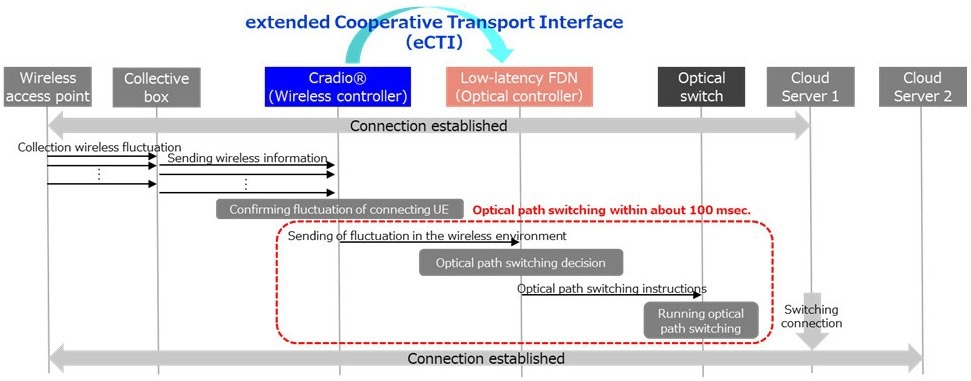NTT Corporation (NTT) conducted a real-time cooperative control demonstration between IOWN APN (All-Photonics Network) and a wireless system in accordance with the state of radio usage toward the application of the IOWN APN to various wireless systems. In the demonstration, we first adopted the extended Cooperative Transport Interface (eCTI) under consideration at the IOWN Global Forum and linked a multi-radio proactive control technology (Cradio®) with a low-latency FDN. By switching the optical path of the IOWN APN in real time in accordance with the wireless usage status, we show that a "robust network" can be provided between the wireless (Wi-Fi) and optical (APN) sections.
 Figure 1. Overview of optical-wireless cooperative-control technology, Image Credit: NTT Corporation
Figure 1. Overview of optical-wireless cooperative-control technology, Image Credit: NTT Corporation
Thanks to this achievement, the mobile robots that support digital transformation (DX) in factories can be operated sustainably, and the connection destination of the APN from the wireless access point to the server can be changed freely in accordance with the usage status (changes in the number of terminals and applications used) and application (big data collection analysis, telerobotic operation) of the operating equipment. Therefore, one IOWN APN line can be shared by multiple applications, and DX efficiency in the factory can be expected to be improved.
Technologies used in this demonstration will be presented at the Tsukuba Forum 2024 to be held from May 16 to 17, 2024.
Background
DX in the manufacturing industry is rapidly expanding against the backdrop of a decline in the working population. More specifically, by collecting and analyzing data on the operation status of equipment in each process in a factory in real time, we have not only taken measures to optimize and improve efficiency but also been actively improving efficiency and eliminating labor shortages by introducing robots. To support DX, both wireless and wired networks need to have high-capacity and low-latency performance as well as reliability that does not disrupt services. Especially for wireless networks, it is important to deal with wireless access environments such as wireless LAN and local 5G that are expected to be used in factories. Power consumption and cost are also issues for DX adoption. From a network perspective, power consumption and costs increase as the number of network lines increases. For this reason, to increase the spread of DX in factories, network circuits need to be efficiently used while ensuring network performance and reliability.
Overview of Demonstration
Two demonstration experiments were conducted by connecting a Wi-Fi access point (AP) and an IOWN APN line in a factory wireless environment, establishing an environment for communication between a wireless terminal under the Wi-Fi AP and a cloud server, and linking a wireless controller that implements the Cradio® function to understand wireless usage status with an optical controller that switches the IOWN APN line via eCTI in real time.
1. Demonstration according to application based on user instruction:
At a factory, assuming a switch from big data collection work to remote robot operation work for each process, we conducted experiments to simultaneously switch the Wi-Fi AP to be used and the optical path to the connected cloud server in accordance with the performance requirements of each work and demonstrated that the cooperation operation was completed.
2. Demonstration according to the number of connected user terminals:
An experiment was conducted at a factory to detect the number of user terminals to be connected and automatically switch the optical path to the connected cloud server on the basis of the information. Results demonstrated that the cooperation operation was completed in about 100 ms.

Figure 2. Operation sequence of optical-wireless cooperative-control. Image Credit: NTT Corporation
Technical Points
- Technology for understanding radio wave fluctuations in the wireless segment and cooperative control with external systems (Cradio®): Cradio® understands radio wave fluctuations in a wireless section by acquiring precise radio environment information from a collection box that constantly collects radio frames in the vicinity of terminals. This technology observes changes in the number of connected terminals belonging to a specific AP and notifies the cooperative control function part (or notifies the cooperative control function part on the basis of user instructions) when such changes occur. The cooperative control function part achieves cooperative control with the low-latency FDN control function, which is an external system.
- Optical-wireless cooperative-control technology: Cradio® and the low-latency FDN control function communicate information such as radio wave conditions, the number of connected terminals, and changes in usage via eCTI, thereby realizing real-time control of wireless and optical sections.
- Network-computing cooperative-control technology: Network-computing cooperative-control technology monitors the transmission time of an optical network and the processing time of applications on an edge server in total, and it simultaneously switches the network path and the edge server used in real time so that the service is sustainable. In this demonstration, IOWN APN was applied as an optical network, and high-speed switching of optical switch was realized.
Future Plans
Optical-wireless cooperative-control technology can be applied to private wireless systems such as Wi-Fi and local 5G, as well as cellular systems such as Beyond 5G/6G. In the future, we will carry out demonstration experiments on the integration of various wireless systems and IOWN APNs, as well as various usage scenarios, with the aim of developing a total network solution business that combines IOWN APNs and private wireless systems.
Also, by the end of fiscal 2024, we will conduct demonstration experiments to reduce the power consumption of mobile systems by applying the elastic load balancing function under consideration at the IOWN Global Forum and linking the IOWN APN with the wireless base station.